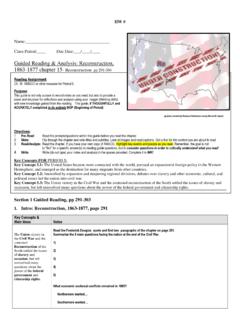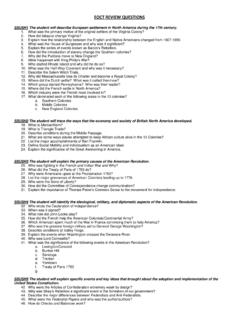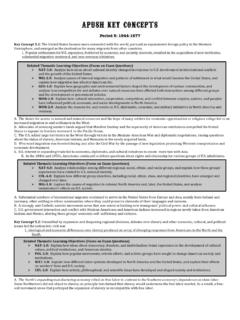Transcription of SS8H6 Notes -- CIVIL WA R CAUSES OF THE WAR
1 SS8H6 Notes -- CIVIL WAR. CAUSES OF THE WAR. SLAVERY. Major type of labor before the war Use of slavery increased due to the invention of the cotton gin Many northern writers called for the end of slavery ABOLITIONIST. Someone who opposes slavery and wants to see it end South wanted slavery in the new territories The North wanted it only where it already existed Resented the North for trying to end slavery STATE'S RIGHTS. belief that the interests of the states were higher than the interests of the federal government US almost broke apart due to states' rights several times Argument was on a right to have slavery Northern States Political decisions should be made to benefit the entire nation All states must ABIDE (follow) rules made by the federal government Southern States States have the right to make their own rules Only states knew what laws would work best for them NULLIFICATION.
2 Belief of the states that they could ignore certain federal laws SC threatened to nullify the tariff They threatened to SECEDE (Leaving the Union). Major issue was possible ban of slavery Slave based agriculture system of the South VS. Manufacturing based economy of the North MISSOURI COMPROMISE (1820). Agreement between the northern and southern states Maintain balance Missouri wanted to enter as a slave state Solution was the Missouri Compromise Missouri entered the Union as a slave state Maine entered as a free state No slavery north of the 36 30' parallel States would now enter in pairs 1 free and 1 slave THE COMPROMISE OF 1850 AND THE GA PLATFORM. California was admitted as a free state Slavery was banned in Washington, The South got the fugitive slave act It guaranteed the return of any runaway slave to their owners GA platform -- Statement passed in support of Compromise Henry Clay asked his GA friends to sign the compromise It would give the free states more representation in the US Senate Purpose of the Missouri Compromise and Compromise of 1850 was to resolve disputes over slavery SS8H6 Notes -- CIVIL WAR.
3 KANSAS- NEBRASKA ACT (1854). Allowed slavery above the 36 30' parallel Written by Senator Stephen Douglas (Illinois). Popular Sovereignty The ability for the states to decide for themselves if they would be slave or free In 1854, Kansas was a territory, it wanted to become a state Soon after their arrival, violence began With all the bloodshed, Kansas became known as bleeding Kansas . Kansas voted to enter as a slave state -- US Congress refused to honor the vote Kansas was admitted as a free state in 1851. Destroyed the Missouri Compromise and Compromise of 1850. Led to the creation of the Republican Party Led to a split in the Democratic Party THE DRED SCOTT CASE (1857).
4 Dred Scott was a slave Taken by his master to the free states Illinois and Wisconsin Returned to Missouri believing he was a free man Missouri law stated If a slave spends any time in a free state, then they are forever free Scott sued for his freedom With the help of northern lawyers Scott appealed to the US Supreme Court Chief Justice Roger Taney said Slaves and freed blacks were not citizens of the US. Slaves are property They do not have the right to sue THE ELECTION OF 1860. Final event that led to the CIVIL war Four candidates ran for president in 1860. Abraham Lincoln -- Illinois Republican Party Had been formed to ABOLISH (end) slavery Due to the issue of slavery Northern and Southern Democrats split into two parties Northern Democrats -- Stephen Douglas -- Illinois Southern Democrats -- John Breckinridge -- Kentucky Lincoln won the election of 1860.
5 The southern states began to vote to secede from the Union THE DEBATE OF SECESSION IN GA. January of 1861. GA was being pressured by SC to join the secession Alexander Stephens gave a memorable speech Begged GA not to secede January 19, 1861. General assembly voted -- 208 - 89. GA seceded from the Union Alexander Stephens signed the Ordinance of Secession on January 21, 1861. Chosen as one of GA's representatives to Confederate Congress Elected Vice President of the Confederate States of America SS8H6 Notes -- CIVIL WAR. THE CIVIL WAR. THE UNION BLOCKADE OF GA'S COAST. Lincoln wanted to cut off the Confederacy from Britain General Winfield Scott comes up with a plan Scott's plan -- The Anaconda Plan Scott said -- Squeeze the life out of the Confederacy.
6 BLOCKADE -- No imports enter and No exports leave All southern ports, including Savannah, would be blockaded The North had a strong Navy They would stop the South from exporting cotton They would stop England and France from sending guns and supplies The South needed ports to stay open to receive supplies Fort Pulaski (GA) is attacked -- The fort was destroyed by the North The North now effectively controlled Savannah ANTIETAM. September 17, 1862. The bloodiest one day battle of the CIVIL war Over 23,000 Americans were killed Confederate Commanding General -- Robert E. Lee (VA). Wanted to invade the North Lee had two major goals He hoped to bring Maryland (a slave state) into the Confederacy He hoped the British and French would help with a major victory on Northern soil This victory did not happen Lee chose to withdraw from Maryland and return to VA.
7 President Lincoln decided that this was a victory He released the Emancipation Proclamation This kept the British and French out of the war EMANCIPATION PROCLAMATION. September 22, 1862. Five days after the battle of Antietam Lincoln issued the Emancipation Proclamation The document is incorrectly described as freeing the slaves . The Proclamation actually said All slaves in rebellious states would be freed on January 1, 1863. At that point only slaves in Confederate states would be free Slaves from the Union states were not free This document also stated If the South surrender before January 1, they would have been allowed to keep their slaves GETTYSBURG.
8 July 1-3, 1863. Often called the turning point of the war During the Battle Lee's outnumbered army failed to gain the high ground This meant they never took control of the battle After three days of heavy loses, the North won the battle After the battle President Lincoln gave one of his most famous speeches The Gettysburg Address -- A short 10 sentence speech SS8H6 Notes -- CIVIL WAR. CHICKAMAUGA. Chickamauga is 10 miles south of the GA/TN line September 18 -- 20, 1863. GA experienced a major battle of the CIVIL War The Battle Of Chickamauga 2nd bloodiest battle of the CIVIL War Largest battle ever fought in the state of GA. This battle was part of a larger Northern objective Capture the city of Chattanooga It was an important railroad center Confederates discovered Union army in the area and attacked It was the largest Union defeat in the Western theater of the CIVIL War Chattanooga was now securely in Union hands It was used as a launching point for William T.
9 Sherman's Atlanta Campaign SHERMAN'S ATLANTA CAMPAIGN. William T Sherman actually led two separate military campaigns in the state The first was the Atlanta Campaign Began in Spring of 1864. Sherman's goal was to capture Atlanta It was the major railroad hub of the South If Sherman could capture Atlanta it would rip the heart out of the Confederacy . Known as heart of the Confederacy because GA had the best railroads and more industry than other Confederate states The Southern army was led by General Joseph Johnston He knew his army was outnumbered almost two to one Sherman chose to simply OUT FLANK (go around) Confederate positions Confederate President, Jefferson Davis, removed Johnston from command Sherman surrounded the city Bombarded it with cannon fire September 2, 1864.
10 General Hood was forced to withdraw from Atlanta This left the city open for Union occupation Ended October 1, 1864. November 15, 1864. Sherman's army left Atlanta He had soldiers set fires throughout the city The city of Atlanta was left smoldering and in ruins The capture of Atlanta also was critical to the North It broke the back of the Confederacy It could no longer supply the Confederate army Finally, it guaranteed Lincoln would win a second term as president SHERMAN'S MARCH TO THE SEA. Also wanted to punish civilians for helping the southern cause He called this policy, TOTAL WAR. Sherman began his infamous March to the Sea on November 15, 1864. It ended on December 21, 1864 with Sherman's capture of Savannah Sherman's army created a path of destruction that was 300 miles long and 60 miles wide Sherman burned buildings, factories, and towns Savannah surrendered to Sherman without a fight on December 22, 1864.




